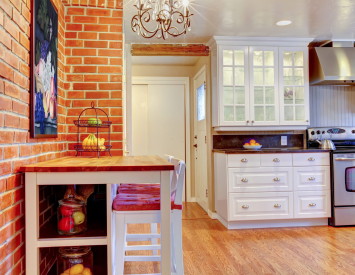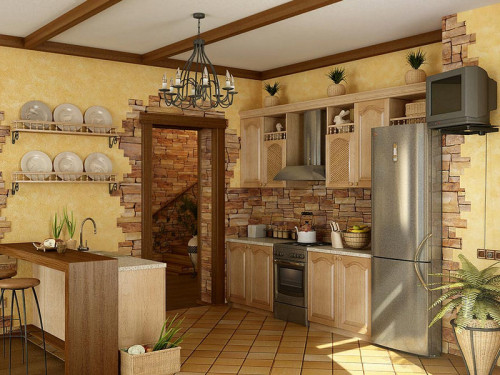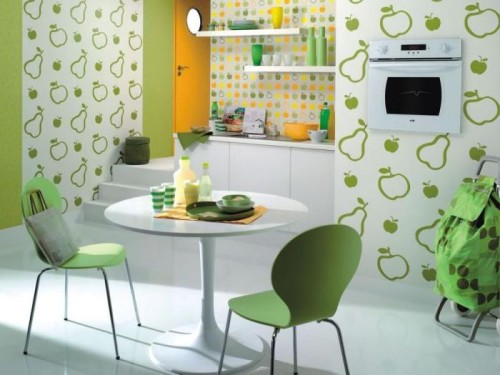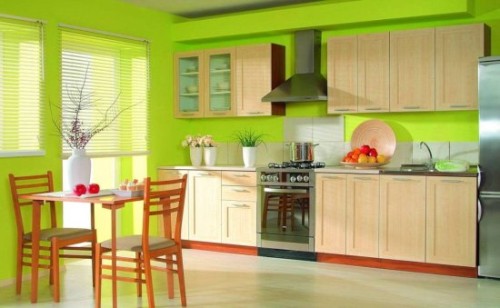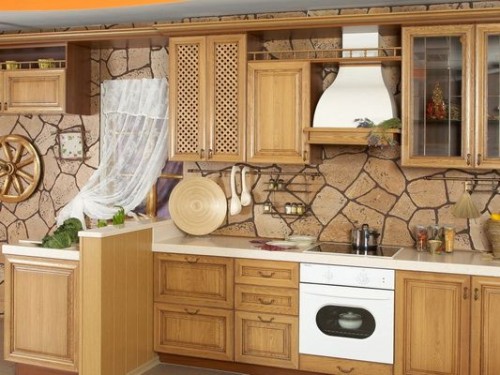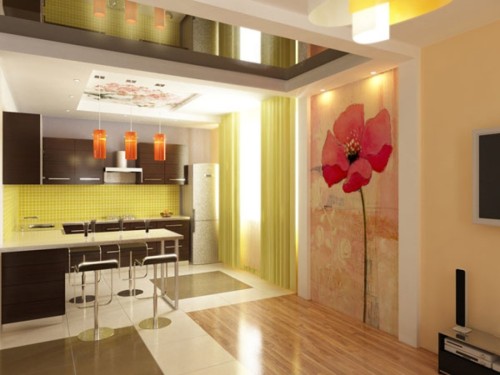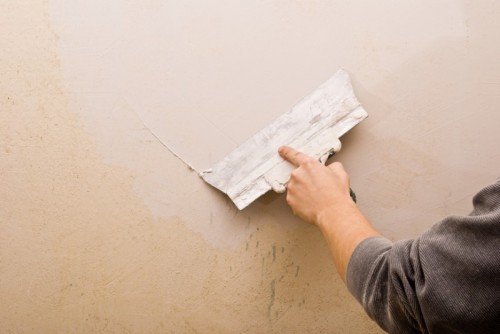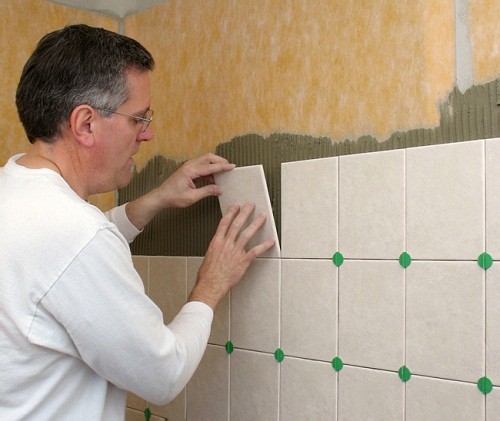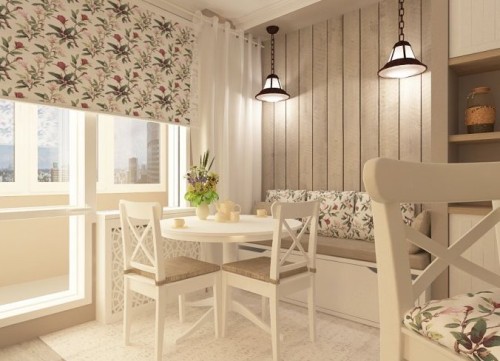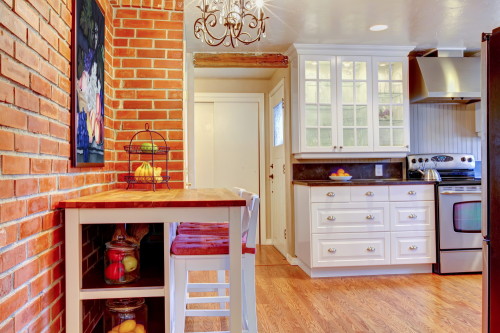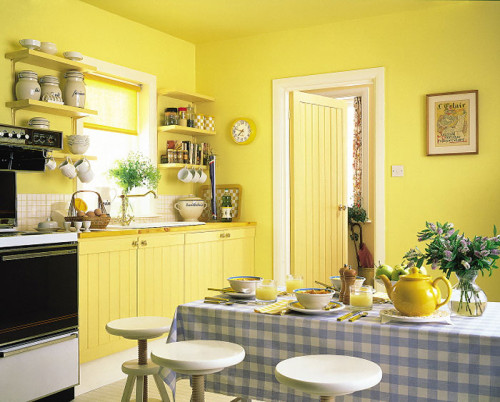The kitchen is one of the most important premises in an apartment or house. Due to its direct purpose-cooking, this room is exposed to various harmful factors, such as temperature changes, steam, fat, high humidity, smoke, etc. All of them do not affect the interior. To level this pernicious influence, you need to choose the right thing than to finish the walls in the kitchen.
Content
Requirements for materials for wall decoration
The most important requirement for the finishing materials that your kitchen will be faced is practical. The surface of the kitchen walls should easily wash without losing its appearance. As a rule, work in the kitchen is associated with a constant risk of wall pollution. Spray of various liquids (juices, coffee and tea, soups and oily broths) can eventually turn the finish into a not quite pleasant picture. Therefore, the surface of the walls in the kitchen should be easily cleaned.
The second requirement is resistance to moisture and temperature changes. This property is especially manifested in winter when, when preparing a large number of dishes, the temperature of the room rises, and then decreases sharply, and a large amount of steam is released. Unconducted for finishing the kitchen, such as paper wallpaper, can lose their properties.
Another of the most important requirements is fire safety. Preparation in the kitchen in most cases is associated with the use of open fire. Therefore, it is not recommended to finish its walls with combustible materials, such as plastic.
The most popular materials for the walls of the kitchen
The design of walls in the kitchen with ceramic tiles. Ceramic tiles. This is a classic in the finish of the kitchen. It is successfully used for a fairly long period, and the popularity of such a finish is only growing. Only the apron can be laid out with tiles - a small area of \u200b\u200bthe wall above the working surface, and possibly the entire perimeter of the walls. The beauty of various drawings, different sizes, the possibility of combining - make this material one of the leaders in the rating of the kitchen decoration.
Advantages:
- easy to wash
- not afraid of moisture
- resistance to temperature drops,
- long service life.
Flaws:
- high price,
- the complexity of installation,
- the need for careful preparation of the surface.
Raping the kitchen walls with wallpaper. They are considered the simplest option for finishing the kitchen walls. Naturally, we are talking about non -woven or vinyl wallpaper. They have a special microscopic coating, which allows them to be washed with a damp cloth using non -abrasive detergents.
Advantages:
- low cost of materials,
- lightness in installation (they can be poisoned with your own hands in a few hours).
Flaws: Wallpaper is traditionally afraid of direct sunlight, they simply fade on them, as well as high humidity and temperature extremes, which can cause their exfoliation from the surface.
Wall decoration in the kitchen plaster. The plaster as a kitchen finish appeared relatively recently, unless, of course, it is considered the same, which was created by the Soviet “Woe-builders” with the application of paint and whitewashing. Today, plasters created on the basis of synthetic or mineral materials are able to noticeably revive the interior of the kitchen, making it more elegant. Minerals include mixtures based on gypsum, lime or cement. Synthetic are based on polymers, such as styrene or acrylic. The color of the walls in the kitchen due to painting on plaster can have a wide spectrum.
Advantages:
- easily stained,
- not too high the price of materials
- simplicity of application.
Flaw: The need to cover the plaster with special compounds to counteract moisture.
Raping the kitchen walls with a stone. This material is an excellent alternative to ceramic tiles. An artificial stone can create a beautiful atmosphere of a medieval castle in the kitchen. If you choose the right lighting for it, the result will be very good. This material has gained popularity as an addition to interiors in the modern style, it is in perfect harmony with furniture of any color and design solutions.
Advantages:
- easy to wash
- simple in styling,
- has a relatively low weight,
- pretty beautiful material.
Flaw: High price.
Decorative wall decoration in the kitchen MDF panels. This material is quite rarely used for facing walls of kitchen rooms. Usually furniture is made from MDF, but recently a large number of designers began to use it as a finish. The main advantage of this material is that it is possible to create an excellent wall design in the kitchen due to the combination of panels with different colors.
Advantages: Great appearance.
Flaws: A rather high cost of repairs, fear of excessive moisture, and, especially, steam.
Simple wall decoration of the kitchen with your own hands
For our kitchen, we have chosen a fairly simple decoration option. The working area will be finished with several rows of ceramic tiles, and the rest - vinyl wallpaper.
After all wiring is installed, we begin to prepare the wall for the starting putty. First of all, we need to press all the wires in the grooves. This is necessary so that when putty, they do not stick out out, which can damage the layer. To do this, dilute a thick solution of starting putty and apply it with a spatula into wired grooves with a step of 0.3 m. We do it carefully. If there is a need, before the putty grabs, we easily hold the wire with a spatula so as not to damage it.
When the putty dries, check the walls in front of the primer. Easy to tap them with a rubber hammer or just a fist. If there are places to lag in the old plaster from the wall, it must be shot down.
Next, it is necessary to clean the wall of the remains of the old wallpaper. To do this, moisten them with water and, when they get wet enough, carefully remove them with a spatula. The next step we proceed to the primer. For this operation, we use an acrylic mixture of deep penetration. We apply it with a thick painting brush. You should not regret the primer. After drying the walls, we apply another layer.
After the walls are dry, we begin putty. The first layer is distributed by the starting mixture. It has a larger grain size, which is very good for leveling walls. To apply the starting putty, we need the following materials:
- A set of spatulas.
- Mixer and drill.
- Rule.
- Level.
- Grouting mesh.
- Perforated corner.
Further work order:
- To begin with, we set the perforated corner to the external and internal corners of the room. We put putty on the corner and gently glue the corner on it in level.
- Let the putty dry a little. Then we begin to apply the second layer. To do this carefully, even layers, from time to time checking by the rule or level the absence of irregularities. If the walls are too crooked, be prepared that you have to apply several layers.
- After applying one layer, we take a large grouting grid and clean the irregularities and roughness. Then the wall is again primed, and, if necessary, we put it down again. Ideally, after the starting putty, a flat surface should be obtained.
- Then apply a layer of finish putty. When breeding, its consistency should resemble thick sour cream. It is applied with a thin layer. After drying, they grind with a small net, and primed.
- The next step will be the gluing of a working apron from ceramic tiles. We have a standard size of 20 cm x 30 cm. Between the two rows of material, we will lay a series of decorative kant.
- The size of the apron should be such that it is 2-3 cm from below to be closed with a kitchen cabinet, and on top with a hinged box. To do this, knowing the height of the cabinet of the kitchen set, we draw the horizontal line - the boundary of the first row using the level. Then, along this line, we set the support for the first row. It can enter a metal profile or a wooden bar. We fasten it on the dowel of quick installation.
- Before laying tiles, the surface can be primed. For this operation, we buy a special glue. We dilute it to the consistency of melted plasticine. To apply glue to the surface of the wall and tiles, we use a jagged spatula.
- There are several crosses between the tiles - they are needed to endure the same distance between them. After installing the second tile, check its position using the level. It should be in level with the first.
- We lay the tile along the rows from the bottom up. If you do this for the first time, do not make a lot of glue. While you will align the tile, it can just dry. When the glue dries, lay the edging, and then the second row, etc.
- After laying the tiles, we wipe the seams. To do this, use grout for seams. They come in various colors, so you can choose for a tile shade.
- The last stroke is the wrapping of wallpaper. This is perhaps the easiest stage in the wall decoration. For him, we need: wallpaper glue, painting brush, wallpaper rubber roller. Dilute the glue according to the proportion indicated by the manufacturer for a specific type of wallpaper. In order to avoid the formation of lumps, we carefully outweigh the solution as the mixture is added. It is better to do this with a mixer.
- Then we take the level and dramat the vertical straight line. On it we glue the first strip of wallpaper. We glue the material gradually from top to bottom, smoothing the roller. We glue the next strip.
- If your ceiling is even, then when forming the joint of the wallpaper, the end of the strip will definitely coincide with its level. If not, an overlap is possible. In this case, do not glue the end of the wallpaper. When the glue dries, gently cut the overlap with a knife and, smearing with an adhesive composition, glue it. That's all, the wall decoration in the kitchen is ready with your own hands.
Walls in the kitchen: photo
